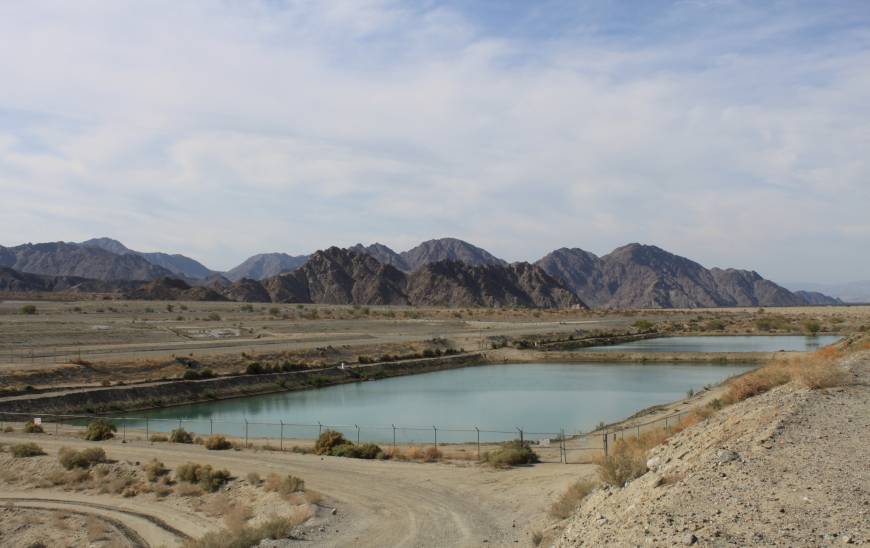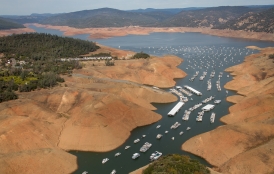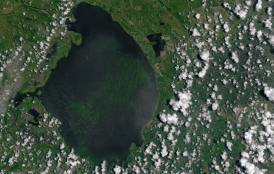The Stanford School of Earth, Energy & Environmental Sciences is now part of the Stanford Doerr School of Sustainability.
This page is currently being maintained for archival purposes only. For the latest information, please visit us here.
Stanford researchers reveal cost-effective path to drought resiliency
California needs to better prepare for droughts. A new study highlights the costs, benefits and obstacles of a possible solution – managed aquifer recharge.
By
Rob Jordan
July 22, 2016

<p>The Coachella Valley recharge basin in California percolates water from sources including the Sacramento Bay Delta and Colorado River into an underground aquifer. (Image credit: Chris Austin/Flickr)</p>
Strained by drought in recent years, California desperately needs more resilient water supplies. An affordable solution that provides a wide range of benefits is within reach, according to a new Stanford study.
Published in San Francisco Estuary & Watershed, the study reveals the costs and benefits of using groundwater recharge and storage across the state. This process, known as “managed aquifer recharge,” or MAR, can incorporate co-benefits such as flood control, improved water quality and wetland habitat protection. The study found the median cost of MAR projects is $410 per acre-foot (the amount of water required to cover an acre of level land at a depth of 1 foot) per year. By comparison, the median cost of surface water projects is five times more expensive – $2,100 per acre-foot.
“We find that MAR is an effective and affordable way to balance local groundwater decisions with regional and statewide management,” said study co-author Debra Perrone, a postdoctoral scholar with Stanford’s Water in the West program.
Many local communities rely on statewide infrastructure to supplement their water supply. This water is costly and limited in supply, raising a need for cost-effective local storage options.
Managed aquifer recharge allows for local water storage, access and management to a much greater extent than large surface water reservoirs, which are often managed by state and federal entities. Although excess surface water can be limited in some regions of California, treated wastewater and urban stormwater offer sources for MAR that aren’t fully utilized by centralized surface water storage infrastructure.
MAR is particularly well suited to more populous and developed areas that can take advantage of large quantities of treated wastewater and stormwater runoff collected by extensive infrastructure for use in recharge. In more rural areas, MAR using excess surface water can still play an important role in replenishing groundwater basins and guarding against dry times.
“Every year, California lets 1 million acre-feet of treated wastewater flow to the ocean,” said co-author Melissa Rohde, previously a researcher with Water in the West. “Our research shows it would cost the state about $870 million to build the necessary MAR facilities to recover and store this water. That’s not a lot of money compared to the cost and energy required to transport water from large surface water projects or to desalinate ocean water.”
A water enigma
Groundwater supplies up to 60 percent of California’s water supply during dry years. Despite its crucial role in slaking the Golden State’s thirst, groundwater went largely unregulated until the 2014 passage of the Sustainable Groundwater Management Act. Therefore, statewide data on groundwater management generally and managed aquifer recharge projects specifically has been sparse or proprietary, generally not shared publicly.
This lack of information was highlighted with the 2015 passage of California’s largest-ever water-related proposition – the $7.5 billion Proposition 1. The bond promises almost $3 billion for water storage projects. Without data on relative costs and benefits, state and local water managers are hard pressed to make informed decisions on MAR projects.
In addition to new funding opportunities, the 2014 law puts the burden on local agencies for sustainably managing groundwater. So, local communities have more reason than ever to bank water sustainably. Managed aquifer recharge allows agencies to do that in ways tailored to a community’s resources.
Perrone and Rohde set out to identify costs and benefits of MAR projects around the state by mining applications for general obligation bonds from ballot propositions. In these publicly available forms, the researchers identified proposed economic costs and anticipated MAR project benefits. Then, they surveyed the projects’ managers to compare initial estimates with actual costs, and to identify advantages and limitations.
Looking to the future
As a changing climate, growing population and other factors put increasing pressures on water supplies, California’s need for long-term resilience will only intensify, the study noted. Conservation will only go so far. Flexible water storage options that can address changing conditions are essential. Therefore, it is likely that more water agencies will adopt MAR as a local management tool.
Funding is critical to the success of groundwater projects, because communities bear the largest burden for financing water projects, according to the paper. The quantification of capital, operation and maintenance, and total costs of MAR projects will assist communities with long-term planning for funding, and thus, long-term management of their aquifers.
The research was supported by Cody Smith and the S.D. Bechtel Jr. Foundation.







